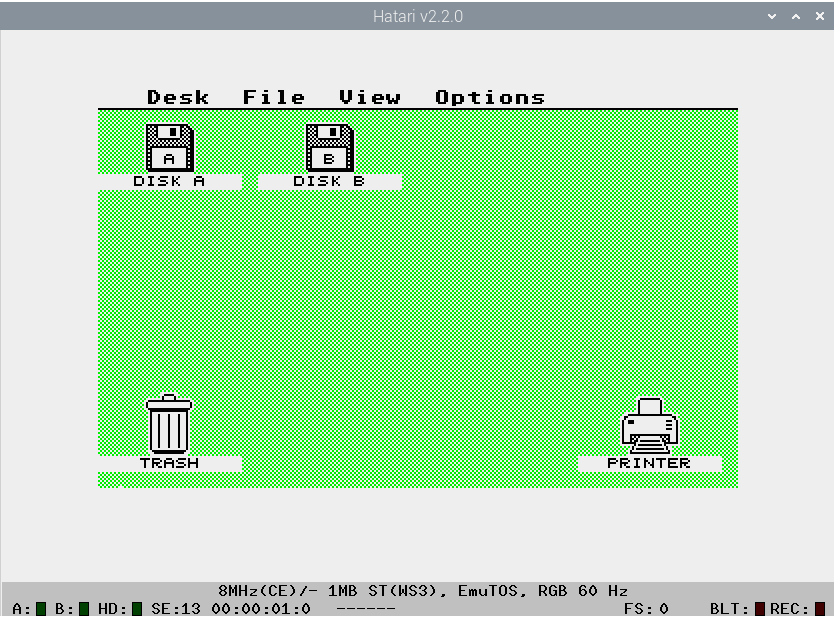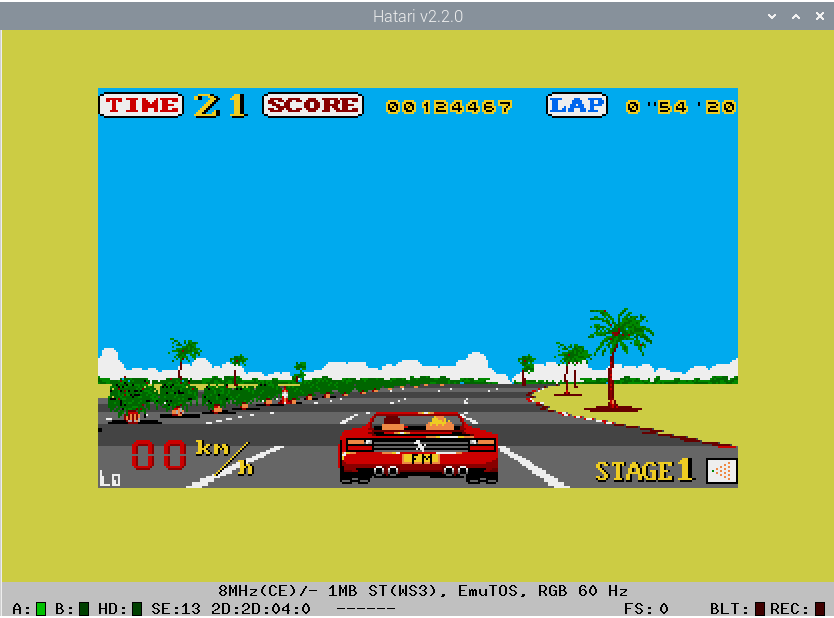Last Updated on April 22, 2022
Hatari
Hatari is an Atari ST, STE, TT and Falcon emulator. The Atari ST was a 16/32-bit computer system, first released by Atari in 1985. Using the Motorola 68000 CPU, it was a very popular computer having quite a lot of CPU power compared to its peers.
Hatari supports the emulation of most of the ST and STE hardware, including some special tricks like raster interrupts, border effects and PSG sample sound.
There’s a package for Hatari available in the Raspbian repositories. So installation is trivial. Note, Hatari also needs a TOS image file for running. TOS is the built-in operating system of the Atari 16/32 bit computers.
The TOS is copyrighted and cannot be distributed by Raspbian. If you have an original Atari ST, you can make an image file from its TOS ROMs. If you don’t own the original hardware, you can download EmuTOS, a TOS compatible operating system that’s free and open source. EmuTOS supports Atari machines, but it’s not as compatible as the TOS operating system.
Here’s an image of the emulator running EmuTOS on the RPI4. I used EmuTOS for my testing.

I tried a number of Atari ST titles on Hatari. Reproduction of the games was faithful. Most games made little demand on the RPI’s CPU, typically using less than 50% of 1 CPU core. I did experience a few issues with sound. Audio playback wasn’t perfect, but more than satisfactory. Something I’ll need to investigate further. Overall, emulation is very good.

Next page: Page 5 – Survey of Home Emulators on the RPI4
Pages in this article:
Page 1 – Introduction
Page 2 – FS-UAE
Page 3 – ZEsarUX
Page 4 – Hatari
Page 5 – Survey of Home Emulators on the RPI4
Read all my blog posts about the RPI4.
| Raspberry Pi 4 Blog | |
|---|---|
| Week 36 | Manage your personal collections on the RPI4 |
| Week 35 | Survey of terminal emulators |
| Week 34 | Search the desktop with the latest version of Recoll |
| Week 33 | Personal Information Managers on the RPI4 |
| Week 32 | Keep a diary with the RPI4 |
| Week 31 | Process complex mathematical functions, plot 2D and 3D graphs with calculators |
| Week 30 | Internet radio on this tiny computer. A detailed survey of open source software |
| Week 29 | Professionally manage your photo collection with digiKam |
| Week 28 | Typeset beautifully with LyX |
| Week 27 | Software that teaches young people how to learn basic computing skills and beyond |
| Week 26 | Firefox revisited - Raspbian now offers a real alternative to Chromium |
| Week 25 | Turn the Raspberry Pi 4 into a low power writing machine |
| Week 24 | Keep the kids learning and having fun |
| Week 23 | Lots of choices to view images |
| Week 22 | Listening to podcasts on the RPI4 |
| Week 21 | File management on the RPI4 |
| Week 20 | Open Broadcaster Software (OBS Studio) on the RPI4 |
| Week 19 | Keep up-to-date with these news aggregators |
| Week 18 | Web Browsers Again: Firefox |
| Week 17 | Retro gaming on the RPI4 |
| Week 16 | Screen capturing with the RPI4 |
| Week 15 | Emulate the Amiga, ZX Spectrum, and the Atari ST on the RPI4 |
| Week 14 | Choose the right model of the RPI4 for your desktop needs |
| Week 13 | Using the RPI4 as a screencaster |
| Week 12 | Have fun reading comics on the RPI4 with YACReader, MComix, and more |
| Week 11 | Turn the RPI4 into a complete home theater |
| Week 10 | Watching locally stored video with VLC, OMXPlayer, and others |
| Week 9 | PDF viewing on the RPI4 |
| Week 8 | Access the RPI4 remotely running GUI apps |
| Week 7 | e-book tools are put under the microscope |
| Week 6 | The office suite is the archetypal business software. LibreOffice is tested |
| Week 5 | Managing your email box with the RPI4 |
| Week 4 | Web surfing on the RPI4 looking at Chromium, Vivaldi, Firefox, and Midori |
| Week 3 | Video streaming with Chromium & omxplayerGUI as well as streamlink |
| Week 2 | A survey of open source music players on the RPI4 including Tauon Music Box |
| Week 1 | An introduction to the world of the RPI4 looking at musikcube and PiPackages |
This blog is written on the RPI4.

Is it possible to play the old Star Raiders Atari game on RPi4?
Yes, works fine.
Thank you for a great series of posts and a good trinity of emulators! I own a RPi 3 but it’s not beefy enough for FS-UAE. This sounds interesting because it’s my Amiga emulator of choice when WinUAE is not an option, simply due to how mature it is and how well it emulates.
I’m really glad you’re enjoying my weekly series about the RPI4. I can only hope people find it as useful as I love writing the blog.
I’m currently up to Week 31, and there’s still tons of programs I want to try on the tiny machine.
Not a single mention of Retroarch? I know that RetroPie is massive, but not everyone wants multiple distros. I run RetroArch (installed similarly to Kodi infact) and on top emulation station, which performs admirably. FS-UAE runs nicely to.
The series is my personal blog chronicling *my* experiences of using the RPI4 as a desktop machine. I write one article a week for free. The series is not designed to be comprehensive in any sense.
If you want to write an article about application X or Y on the Raspberry Pi4, send it to LinuxLinks.